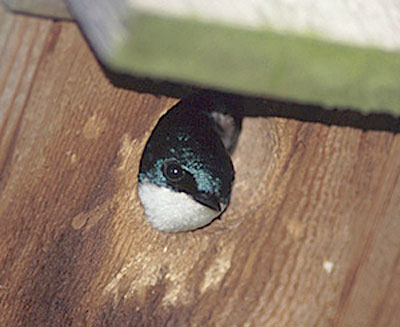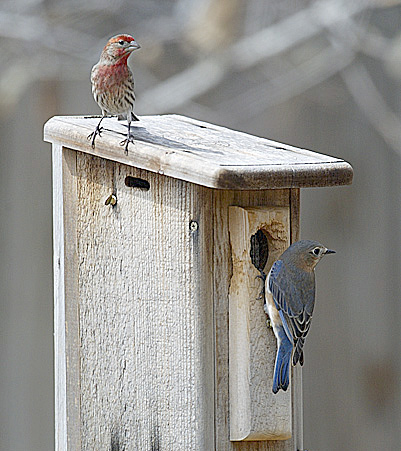
Establishing your own bluebird trail can be fun and rewarding but requires a real commitment of time and effort.
A typical trail usually consists of five or more bluebird boxes along a prescribed route. The boxes need to be inspected and repaired in the spring and checked every week during nesting. Boxes are usually cleaned after nesting. Trails should not be started if time is not available to check and maintain the boxes during the nesting season. Unmanaged trails are at risk of raising more house sparrows than bluebirds.
Keeping records of the activity on your bluebird trail can be fun and can provide valuable information. The North American Bluebird Society (NABS) compiles data on bluebird populations in North America.
If tree swallows, chickadees or other native species are taking over your bluebird boxes; try placing two nest boxes about 5 – 25 feet apart. Nesting tree swallows, for example, will not allow another pair of swallows to move in so near, but will not bother the bluebirds.
On this page
Location
Habitat is the most important factor to consider in establishing your trail. Rural locations with scattered trees and low or grassy ground cover are preferred. The best habitat will include nearby fence lines, telephone wires, or tree branches where bluebirds may perch to search for food. Pastures, golf courses, cemeteries, and parks are good locations.
Stay away from areas with high pesticide usage. Avoid locating houses too close to buildings, bridges and major power line poles that house sparrows frequent. Also avoid brushy areas that can attract other nesting species and predators.
Nest boxes
Proper monitoring and spacing of the nest boxes for bluebirds will increase the chance for a successful bluebird trail.
– Nesting boxes should be mounted so the entrance hole is five to six feet above the ground.
– Face the box away from prevailing winds.
– Boxes should ideally face toward a tree or shrub which is within 100 feet of the box. This provides easy access for young birds leaving the nest.
Eastern Bluebird – Boxes should be spaced at least 100 to 150 yards apart. Some experts recommend placing boxes in pairs about 25 feet apart, with the pairs then 100-150 yards apart.
Western and Mountain Bluebirds – Boxes should be spaced about 200 – 300 yards apart.
Bluebird boxes should typically be in place by mid-March (early March in southern states where bluebirds are year-round residents), but may also be put up later in the nesting season.
Monitoring a bluebird trail
Checking your bluebird boxes during nesting season is one of the most interesting and important parts of managing your trail. It is not wise to start a bluebird trail if you do not plan to monitor it. Check the bluebird boxes at least once a week during the nesting season but do not open the box after nestlings are 13 days old (16 days for the mountain bluebird).
The young birds might leave the box before they can fly.

House finch scoping out a bluebird box.
Here are a few other tips:
- Bluebirds usually nest in late March or early April. In the southern U.S. bluebirds are resident throughout the year and may nest earlier.
- Bluebirds usually have two broods per season, with three broods a possibility.
- Bluebirds typically lay 4 to 5 light blue eggs, but as many as 7 or 8 is possible. Some eggs may be white.
- The incubation period is about 14 days. (See the individual species profile)
- Young bluebirds remain in the nest 15 to 21 days before they fledge. (See the individual species profile for more exact information.)
- Remove bluebird nests, clean out the nest box. Some managers close the box after they are sure nesting is complete for the season. Remember that two or even three broods may be raised. Wait several weeks after the first brood has left the nest to ensure that it will not be used again that year.
- A bluebird nest is cup-shaped and is usually made of grass or pine needles.
- A house sparrow nest is a thick collection of grass, weeds and junk and can fill the entire bluebird house.
- Remove house sparrow nests immediately.
It may take several seasons for bluebirds to locate and select your nest boxes but your patience will be well rewarded when you attract your first residents. Their sweet calls and shimmering beauty are well worth the effort.

